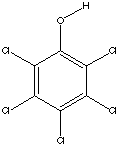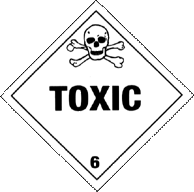Pentachlorophenol
- PCP
- Penta
- Penchlorol

Pentachlorophenol | |
| |
| Formula | C6HCl5O |
| Structure |  |
| Description | A white crystalline solid. |
| Uses | As a molluscicide, fungicide, herbicide, insecticide, plant growth regulator. |
| Registry Numbers and Inventories. | |
| CAS | 87-86-5 |
| EC (EINECS/ELINCS) | 201-778-6 |
| EC Index Number | 604-002-00-8 |
| EC Class | Carcinogenic Category 3; Very toxic; Toxic; Irritant; Dangerous for the Environment |
| EC Risk Phrase | R 24/25 26 36/37/38 40 50/53 |
| EC Safety Phrase | S 22 36/37 45 52 60 61 |
| RTECS | SM6300000 |
| RTECS class | Agricultural Chemical and Pesticide; Tumorigen; Mutagen; Reproductive Effector; Human Data; Primary Irritant |
| UN (DOT) | 3155 |
| Merck | 12,7242 |
| Beilstein/Gmelin | 1285380 |
| Beilstein Reference | 4-06-00-01025 |
| RCRA | D037 |
| EPA OPP | 600021 |
| Swiss Giftliste 1 | G-2068 |
| Canada DSL/NDSL | DSL |
| US TSCA | Listed |
| Austrailia AICS | Listed |
| New Zealand | Listed |
| Japan ENCS (MITI) | Listed |
| Properties. | |
| Formula | C6HCl5O |
| Formula mass | 266.34 |
| Melting point, °C | 188 |
| Boiling point, °C | 310 |
| Vapor pressure, mmHg | 0.0003 (25 C) |
| Vapor density (air=1) | 1.98 |
| Density | 1.978 g/cm3 (22 C) |
| Solubility in water | 10 mg/L |
| pKa/pKb | 4.68 (pKa) |
| Partition coefficient, pKow | 5.12 |
| Heat of vaporization | 57.2 kJ/mol |
| Hazards and Protection. | |
| Storage | Store in a tightly closed container. Store in a cool, dry, well-ventilated area away from incompatible substances. Poison room locked. |
| Handling | Wash thoroughly after handling. Remove contaminated clothing and wash before reuse. Minimize dust generation and accumulation. Do not breathe dust, vapor, mist, or gas. Do not get in eyes, on skin, or on clothing. Keep container tightly closed. Do not ingest or inhale. Use only in a chemical fume hood. |
| Protection | Eyes: Wear appropriate protective eyeglasses or chemical safety goggles as described by OSHA's eye and face protection regulations in 29 CFR 1910.133 or European Standard EN166. Skin: Wear appropriate protective gloves to prevent skin exposure. Clothing: Wear appropriate protective clothing to prevent skin exposure. |
| Respirators | A respiratory protection program that meets OSHA's 29 CFR 1910.134 and ANSI Z88.2 requirements or European Standard EN 149 must be followed whenever workplace conditions warrant a respirator's use. |
| Small spills/leaks | Vacuum or sweep up material and place into a suitable disposal container. Avoid runoff into storm sewers and ditches which lead to waterways. Clean up spills immediately, using the appropriate protective equipment. Avoid generating dusty conditions. Provide ventilation. |
| Stability | Stable under normal temperatures and pressures. |
| Incompatibilities | Strong oxidizing agents, strong bases, acid anhydrides, alkalies, acid chlorides, organic materials. |
| Decomposition | Hydrogen chloride, carbon monoxide, irritating and toxic fumes and gases, carbon dioxide, chlorinated phenols. |
| Fire. | ||||
| Flash Point,°C | 134 | |||
| Fire fighting | Wear a self-contained breathing apparatus in pressure-demand, MSHA/NIOSH (approved or equivalent), and full protective gear. Water runoff can cause environmental damage. Dike and collect water used to fight fire. During a fire, irritating and highly toxic gases may be generated by thermal decomposition or combustion. To extinguish fire, use water, dry chemical, chemical foam, or alcohol-resistant foam. Use extinguishing media most appropriate for the surrounding fire. Cool containers with flooding quantities of water until well after fire is out. | |||
| Fire potential | Non-combustible, substance itself does not burn but may decompose upon heating to produce corrosive and/or toxic fumes. | |||
| Hazards | Contact with metals may evolve flammable hydrogen gas. | |||
| Combustion products | Generates toxic and irritating vapors. | |||
| NFPA | Health | 3 | ||
| Flammability | 0 | |||
| Reactivity | 0 | |||
| Health. | |
| Exposure limit(s) | TLV: 0.5 ppm; mg/m3 (as TWA) (skin) (ACGIH 1991-1992). MAK: class III A2; H (1993). OSHA PEL: TWA 0.5 mg/m3 skin NIOSH REL: TWA 0.5 mg/m3 skin NIOSH IDLH: 2.5 mg/m3 |
| Carcinogin | G-A3, I-2B, CP65 |
| Poison_Class | 3 |
| Exposure effects | Possible cancer hazard based on tests with laboratory animals. May cause liver and kidney damage. Animal studies have reported that fetal effects/abnormalities may occur when maternal toxicity is seen. Chronic exposure has resulted in an increase prevalence of conjunctivitis, sinsuitis, bronchitis, polyneuritis, and dermatitis. Exposure may cuased blood effects and bone marrow damage. Chronic exposure may cause lung damage. Laboratory experiments have resulted in mutagenic effects. |
| Ingestion | May be fatal if swallowed. Causes gastrointestinal irritation with nausea, vomiting and diarrhea. May cause liver and kidney damage. May cause effects similar to those of acute inhalation. |
| Inhalation | May be fatal if inhaled. May cause increased perspiration, increased temperature, increased heart rate, increased breathing, weakness, nausea, vomiting, abdominal pain, headache, Systemic intoxication is cumulative and has been fatal. May cause violent sneezing and coughing. Inhalation may cuase damage to the circulatory system and heart and possible death due to cardiac failure. Causes irritation of the mucous membrane and upper respiratory tract. |
| Skin | May be fatal if absorbed through the skin. Substance is rapidly absorbed through the skin. Causes symptoms similar to those of inhalation. Causes skin irritation and possible burns. |
| Eyes | Causes eye irritation and possible burns. May cause visual damage, inflammation of the conjunctiva, corneal opacity and slight physiologic dilatation of the pupil. |
First aid |
|
| Ingestion | If victim is conscious and alert, give 2-4 cupfuls of milk or water. Never give anything by mouth to an unconscious person. Get medical aid immediately. Induce vomiting by giving one teaspoon of Syrup of Ipecac. |
| Inhalation | Get medical aid immediately. Remove from exposure to fresh air immediately. If breathing is difficult, give oxygen. DO NOT use mouth-to-mouth respiration. If breathing has ceased apply artificial respiration using oxygen and a suitable mechanical device such as a bag and a mask. |
| Skin | Get medical aid immediately. Immediately flush skin with plenty of soap and water for at least 15 minutes while removing contaminated clothing and shoes. Wash clothing before reuse. |
| Eyes | Immediately flush eyes with plenty of water for at least 15 minutes, occasionally lifting the upper and lower eyelids. Get medical aid immediately. |
| Transport. | ||
| UN number | 3155 |  |
| Response guide | 154 | |
| Hazard class | 6.1 | |
| Packing Group | II | |
| USCG CHRIS Code | PCP | |
| Std. Transport # | 4921227 | |